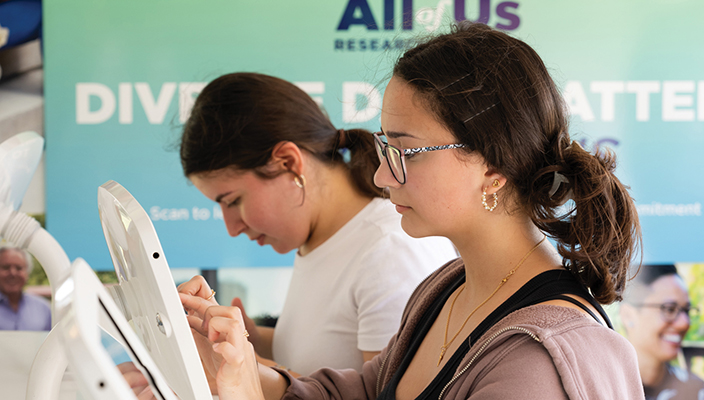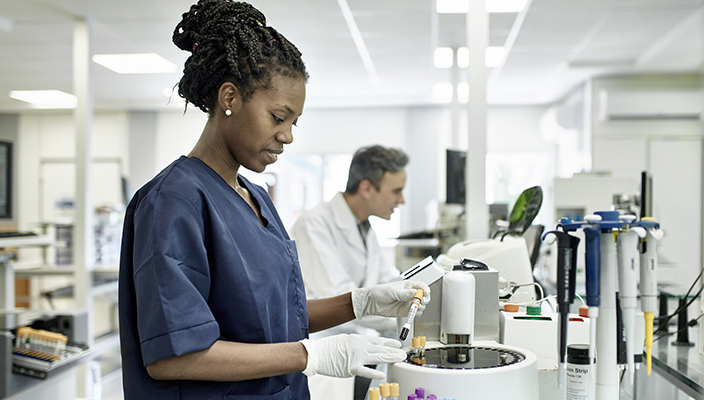Miguel Flores Jr. unites worlds.
For 5 years he’s helped the All of Us Research Program engage with Tribal communities. For 30 years he’s shown governments, schools, and Tribal Nations how to build partnerships and awareness. His constant goal is to create a better understanding on all sides.
Flores is a substance-abuse counselor, traditional healer, and community leader in Tucson, Arizona. He was raised there in his family’s Indigenous Mexican traditions. But he also belongs to the Pascua Yaqui Tribe and the Tohono O’odham Nation. Flores speaks English, Spanish, Yaqui, and O’odham.
Those languages and traditions inspire Flores and his work. Flores became involved with All of Us in 2018. He advised the University of Arizona at Tucson then on how to respectfully reach out to Indigenous communities.
Now he’s a member of the All of Us Steering Committee. There he continues to help guide the program.
“Flores’s work has let All of Us create a more inclusive program to better meet the needs of Tribal Nations,” said Michael Hahn. Hahn is the All of Us Tribal Engagement and Outreach Branch chief. “We are committed to working with Indigenous communities to advance medical research that can benefit all of us.”
In September 2023, All of Us awarded $1.5 million to the University of Arizona (and other institutions). The funds will help Tribal Nations advance health equity and precision medicine. Now the university is developing a tool to measure when the community is ready to participate in the program. Flores said respecting tribal sovereignty is the key to boosting readiness.
“If we are open and honest, All of Us can bring a lot of benefits to Tribal communities,” Flores said. But it “takes time. We need to build long-standing relationships.”
Generations of Caring
Flores knows about the importance of relationships. He’s a fourth-generation Tribal member. His maternal great-grandmother fled Mexico on foot. She left when the government began deporting Indigenous members from their village. In Arizona she was a Pascua Yaqui Tribal midwife from the 1920s to the ’70s. She passed away in 1992, at the age of 104. When she died, Tucson’s Kino Community Hospital named its labor and delivery room after her.
Her legacy lives on in her great-grandson. Flores was inspired by her resilience and community commitment.
Flores was the first in his family to finish high school and go to college. On campus, he joined a program called Y.E.S. (Youth Enrichment Services). It offered after-school tutoring to children in kindergarten through sixth grade. That’s where Flores’s passion for counseling began.
“I had a good rapport with the kids,” Flores said. “It really changed my life course.”
Y.E.S. trained him to merge art and cultural traditions. He also learned ways to prevent violence. Later, Flores pursued mentoring jobs with the Tohono O’odham Nation. He got a state license to be an independent substance-abuse counselor. He was also certified as a treatment specialist for sex offenders. Then he opened his own counseling business.
Patricia S. Nye, M.D., is a retired captain in the U.S. Public Health Service. For 18 years she directed behavioral health at the Tucson Area Indian Health Service office. Flores worked under her there. She said he’s a great counselor because he learns from his own experiences. His “profound understanding and respect for his own background” makes him who he is.
“He has known from childhood that he possesses a gift and the responsibility to use his gift for healing and wholeness,” she once wrote of him.
A Healer and Leader
Flores educates his communities about health and health care. He tells them why medical research is important. And he explains why new research needs to include them. Then he helps All of Us program leaders talk with Tribal communities in ways that respect their cultures and customs.
“Generational trauma from research has had a negative impact on our communities,” Flores said. “Many broken promises, broken treaties.”
But Flores said the ongoing talks are starting to pay off. Government and Tribal leaders are gaining a better understanding of the other’s perspectives.
“Sometimes,” Flores said, “we have two different philosophies of how things get understood — two different timeframes.”
Flores’s role is to develop a bond between the two groups. He helps build a shared understanding and a path forward.
Yet challenges remain. For example, All of Us participants who share a blood or saliva sample can ask to see their own genetic health-related results. These show if the person’s DNA and medication history put them at greater risk of hereditary diseases. But different groups perceive the DNA samples themselves very differently.
“A lot of researchers just see DNA as a sample,” Flores said. “As Indigenous people, we see it as a gift. We’re giving you part of our life.”
Now 30 years into his career, Flores remains committed to teaching Native customs.
“I have always been proud of who I am and where I am from,” he said. “It’s my job to help people understand the significance, the meaning.”
To learn more about All of Us’ activities with Indigenous and Tribal communities, visit https://allofus.nih.gov/about/diversity-and-inclusion/tribal-engagement.”










